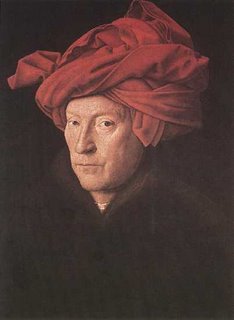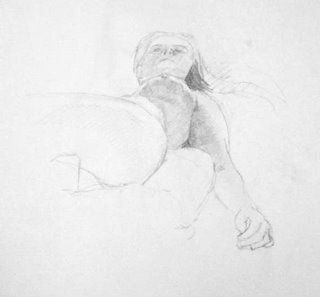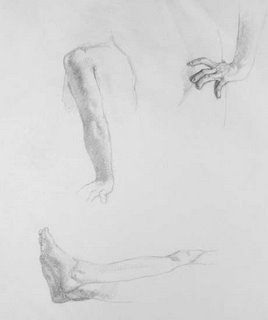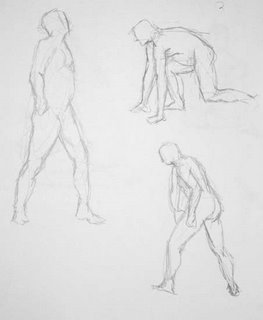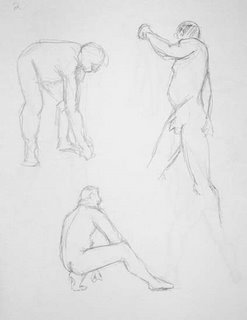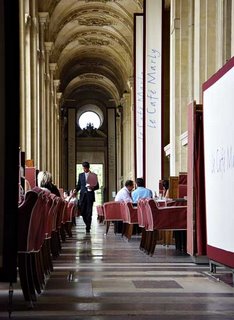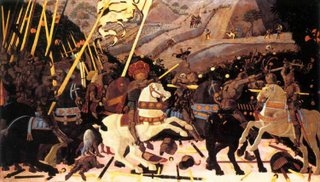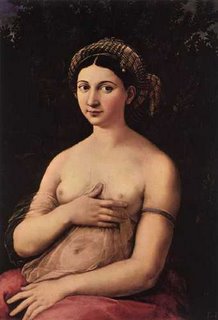Identifying chroma
As with value and hue, the best way to identify chroma is in terms of relationships. How intense is the color you're looking at compared with the intensity of other colors around it? Chroma can be hard to separate out from value; light colors sometimes look more intense than they are, and dark colors sometimes look less intense. You get better with practice.
Bad chroma!
Many artists—mostly amateurs, but also some professionals—seem to have trouble identifying chroma correctly. They often paint at a higher chroma than what they see, and they often seem unaware that they are doing so. Let me give you an example. I was browsing through art books in a bookstore the other day and found one about the painting techniques of the impressionists. It’s a very well written book, based on lots of research on the individual methods of many 19th century artists. There are a number of demonstrations in which the author copies a section of an impressionist painting, using the methods of the original artist. In every single case, throughout the entire book, the author gets the chroma badly wrong and pretty much everything else right. In particular, almost every color is one or two chroma steps higher than the corresponding color in the original. Impressionists were not known for making dull pictures, but the author felt the need to “improve” the originals by bumping the chroma, even though she was clearly making a serious attempt to use the same or similar pigments and techniques. What’s more, I don’t think she knew she was doing it. I think she believed she was doing precise copies, but failed to see chroma differences right in front of her face. That’s just a guess on my part; some of the pigments used in the typical impressionist palette were fugitive, so she might have been deliberately compensating for their tendency to fade. But if that’s the case, I couldn’t find where she told us that, and she was certainly increasing the chroma even in areas corresponding to those painted with lightfast pigments. So either the reproductions in the book are badly messed up (and no one caught it) or this artist has a remarkable insensitivity to chroma.
I see similar errors on internet forums in which amateur artists post copies of old master works. The chroma is usually too high—often much, much too high. That might have something to do with how the work has been photographed, digitized, and presented on computer monitors, but in case after case, the posted copy appears consistently more chromatic than the original, even when the artist has shown them side by side. The artists usually seem unaware of this difference, and sometimes have trouble seeing it even when it is pointed out to them.
There is, of course, nothing wrong with deliberately pushing chroma for dramatic or decorative effect. I do it myself sometimes. My concern is with artists who do this unthinkingly, either because they just have an unconscious bias toward “brighter” color, or because they think that chromatic colors are always better or prettier. I think part of the problem is that we have been conditioned to think about pictures in terms of photography. Many artists work from photographs, and even those who do not have spent a lot of time looking at photographs. Most color films and developing methods are deliberately designed to push the chroma, and most consumer digital cameras are designed to do so as well. That makes the scene more “colorful,” and many people seem to think that a “good” snapshot is one that has a lot of chroma, regardless of how chromatic the original scene was. Over time, we’ve become accustomed to looking at pictures with lots of color intensity. That’s what we think pictures are supposed to look like. And, I suppose, many of those who buy art think that way as well, so there may be a commercial incentive to paint very “colorful” pictures.
If you are looking to make a painting that seems like it is full of color, the problem is this: if you are looking at an array of high-chroma colors, the visual system habituates. We see chroma (and other aspects of color) in terms of relationships at least as much as we see absolute values. A whole bunch of intense colors looks lurid, but it doesn't give the impression of a really colorful scene. The better impressionist painters, for all of their emphasis on a modern palette of intense colors, understood this. They used chroma carefully, calculating the effect of one color against another. They were able to get high chroma colors to really stand out by juxtaposing them against much duller colors or dull optical mixtures, deliberately creating a strong visual contrast. That’s something the author of that book on impressionist technique didn’t seem to understand, for all of her impressive technical knowledge of impressionist methodologies. She’s looked at hundreds of impressionist paintings and copied dozens of them, yet she fails to see how those artists used chromatic contrast. Her copies, as a result, are much less interesting than the originals.
If you like color, then learn how to identify the chroma you see around you. Learn how to mix and use subtle mixtures of neutral and near-neutral colors. If you like intense colors, learn how to create the visual impression of really high chroma by using contrast, rather than just blasting away with unmixed colors right out of the tube and hoping the viewer likes “colorful” art. Even today, with a viewing public accustomed to artificially enhanced color, there are plenty of really good artists who know how to use color more effectively, and they stand out from those who do not. So let’s put an end to chroma cluelessness.
I’ll close my little editorial rant here with this: Enough with those bright orange skin tones already! Even Caucasians who spend way too much time in tanning booths have skin that’s way less intense than cadmium red mixed with yellow ochre, or any of the other ways to mix luridly awful skin tones. Thank you very much.
We’ll now return to your regularly-scheduled paint mixing post.
Working with low-chroma color
Almost all paints are high in chroma right out of the tube. Since most of the world is low in chroma, the majority of a realistic painting will consist of neutrals and near-neutrals. So a realist painter is going to have to spend a lot of mixing time reducing the chroma of paint.
How do you do that? At one level, it's easy because, most of the time, whenever you mix one blob of paint with another blob of paint, you end up with something lower in chroma. By that, I mean that the result is less intense than the brighter of the two colors. Often, it's less intense than either of them. So if you want to reduce the chroma of a paint color, pick another paint that's lower in chroma smoosh them together. The problem, of course, is that if you also want to have control over hue and value, you’re going to have to pick your mixtures carefully.
Reducing chroma with mixing complements
A common method of chroma reduction is to mix in a complementary or near-complementary paint. For example, if you want to reduce the chroma of a bright pthalo green, mix in a violet-red (i.e., a magenta). Complements will usually reduce both chroma and value. You also sometimes get hue shifts when mixing colors from the other side of the color mixing wheel—the mixture follows a curved path around the wheel rather than a straight path toward the center. Because of the peculiarities of individual pigments, there is no way to predict these hue shifts without just mixing two paints together and seeing what happens. You can pull the mixture back to the original hue, however, by adding a third paint that is complementary to the color you’ve mixed. Once you have the hue and chroma right, you’ll need to check to see if the value has now been brought too low. Of course, if you add white to increase the value, the chroma will be decreased. So the method of adding the complement can result in frustration as you try to chase the color of a mixture to the right combination of value, hue, and chroma. For low-chroma colors, I find this process much less frustrating when I start with fairly low-chroma paints, such as earth colors and a few others. That way, I do less chasing of color and less mixing overall. It’s also easier if you mix each color to the correct value first, then mixing them together for the desired hue and chroma.
Yellows and violets, although they are on opposite sides of the color mixing wheel, don’t work well as complements (the hues shift severely rather than mixing toward neutrals). To dull down a yellow, it is easiest to mix in a duller yellow or orange, such as raw umber or raw sienna. You can also mix in a neutral gray of the same value (see below). To get a dull violet, the easiest course is often to ignore violet pigments and mix your own violet. Because mixing reduces chroma, the right combination of red and blue will give you a violet of the desired degree of dullness. A good dark dull violet can be made with ultramarine blue and burnt sienna, for example.
Other than yellow and violet, it is very helpful to experiment with, and memorize, pairs of complementary colors. As a general rule, if you want to dull down an intense color, choose a dull complement. Blues have mixing complements in the range of warm yellows, oranges, and middle reds. Middle and cool greens have mixing complements in the range from middle reds to violets. Warm greens have mixing complements among the violets. Some of my favorite mixing complements include raw sienna/ultramarine blue, viridian/pyrol ruby, Prussian blue/Venetian red, and ultramarine blue/raw umber. I expect that most artists develop a set of strongly preferred mixing complements.
Reducing chroma with optical color mixing
If you put a bunch of small dabs of different colored high chroma paints next to each other, then step back far enough, they will blend optically and look like one color. The perceived color will resemble what you would get if you mixed all of those colors together—i.e., it will be lower in chroma than the colors that go into it. If you take this approach to extremes, you get pointillism, which I don’t personally find to be very attractive or effective. Used with more subtlety, however, optical mixing can be one of the best ways to make neutrals, because by controlling the structure of paint blobs, you can create effects that are much more visually interesting than a flat region of neutral color. The eye sees the optical blend, but is also aware of the color variation. You can partially blend colors together, layer them on top of each other while allowing different amounts of lower colors to show through, create interesting textures, or use any of a number of techniques for optical color blending.
Reducing chroma with white
Almost all colors lose chroma when mixed with white (as I’ve already noted, a few dark cool transparent pigments show an initial increase in chroma when mixed with a little white, then drop chroma as they are lightened further). Of course, they also get lighter, but dull light colors are often exactly what you want. For example, imagine that you are painting a piece of blue cloth. The part of the cloth that is highest in chroma will be the “midtones”—the part of the cloth that is illuminated, but is near the form shadow boundary (the terminator) and turning away from the light. As the form turns toward the light it gets lighter in value and also less chromatic. You can create the same effect with paint by mixing a blue color (cobalt blue, say) with more and more white as it turns toward the light. The paint becomes lighter and less chromatic, just as the blue cloth does. You may need to adjust the mixture to make the chroma, value, and hue changes exactly model what you are seeing in front of you, but just mixing with the appropriate amount of white gets you into the right ball park.
Sometimes, you’ll find that white reduces chroma faster than you want it to. The mixture becomes “chalky.” I’ll discuss how to deal with that problem below, when I talk about high chroma color mixing.
A color that has been lightened by mixing with white is called a tint. Tints are high in value and low in chroma. They are also called “pastels.”
Reducing chroma with grey
Instead of using mixing complements, it is possible to reduce the chroma of a mixture without having much effect on value or hue. To do that, use a neutral gray of the same value. The chroma will go down without significantly affecting the other parameters of color. Black mixed with white does not make a neutral gray—it’s much too cool. A 50/50 mixture of ivory black and raw umber, however, is very close to neutral. Adjust the value of this mixture by adding whatever amount of white is required. You may want to mix up a string of neutral grays in advance and use them to easily adjust chroma. You can also buy a set of neutral gray oil paints from Studio Products, graded according to Munsell chroma intervals.
So here’s a good way to work with low-chroma colors without driving yourself nuts. First, start with low-chroma colors such as earths. They will still be too high in chroma for a lot of purposes, but they are a lot closer than, say, a cadmium red light. Second, pre-mix strings of colors you’re likely to use. Each string is one hue, ranging in value from the lowest you will need to the highest. Also mix a string of neutral grays in the same value range. Small chroma adjustments are fairly easy with nudges of small amounts of complementary colors. When you need to pull the chroma down significantly, first mix the right hue and value from combinations of paint from your strings and, if needed, nudges of other colors on your palette. Then adjust the chroma downward by adding some of your neutral gray at the same value as the mixture you’re working with.
Reducing chroma with glazing
If you paint one color thinly over another color, you get an optical mixture. Blue glazed over yellow produces a green, for example. You can use this effect to reduce chroma, since an optical mixture is darker and duller than the colors that make it up. Michelangelo, for example, sometimes made a dark dull blue by glazing ultramarine over black.
The browns and the brown-ish
It’s worth briefly discussing brown colors. Brown doesn’t appear in the visual spectrum or in the named colors on the outside of a color mixing wheel. Colors labeled “brown” are yellows and oranges that are fairly dark and low in chroma. Brown, therefore, isn’t a color per se: it’s a zone within the overall color mixing wheel. There are plenty of earth colors that start out in the zone of brown, and a few non-earths as well. To make a bright yellow or orange more brownish, it needs to be dulled down and darkened (mixing with white won’t do it; you get a pastel tint). If you mix a yellow or orange with a gray of equal value, you will usually get something you could call a brown. If you mix with black, you will almost always get a brown. Some yellows, when reduced in chroma with grey or black, shift their hue toward green. Just a touch of grey or black makes a green gold; more grey or black makes a greenish umber-like color. Bright yellow-reds (oranges), if dulled down with grey or black, make more clearly brown colors, without those green tones. Bright reds, if dulled down with grey or black, make a maroon.
A color that has been darkened by mixing with black is called a shade. So a mixture of cadmium red and black would be a shade of cadmium red. Because even a little bit of black reduces chroma drastically, some artists banish black from their palette, claiming that it is a “dead” color. That’s silly, because there are times when you want dark colors that are very low in chroma. The real world has such colors in it, after all, and many great Old Master paintings were made with the liberal use of black. Nevertheless, you should be aware of how powerful black is as a reducer of chroma and use it with care.
Working with high-chroma color
For almost all colors, chroma is highest with paint straight out of the tube. Some pigments that are dark and transparent (such as Prussian blue or pthalo green) reach maximum chroma with the addition of a little white. Generally, however, if you want high really high chroma, the way to get it is to have a tube of paint with exactly the right hue and value, and just paint with that. Sometimes, you can make that work. At other times, you don’t have quite the right color, or the right color just doesn’t exist in pigment form.
The highest chroma mixtures are blends of high-chroma paints of similar hue. If your cerulean blue is just a bit too greenish, don’t mix it with red, mix it with a high chroma middle blue such as cobalt blue. You want to draw a line through the color mixing wheel that stays as close to the outside of the wheel as possible. So if you like to work with a lot of high chroma colors, then it’s to your advantage to have many tubes of high-chroma paint. That way, when you want a particular color, you will usually have two colors that are similar enough to that color that you can mix them without taking too much of a hit to the chroma.
Warm colors are at their highest chroma when they are fairly light (high in value). Cool colors are at their highest chroma when they are relatively dark. At maximum chroma, warm colors are more chromatic than cool colors. But that’s OK, because warm colors have higher maximum chroma in the real world as well. If you want cool colors to compete for the viewer’s attention with warm colors, however, you’ll need to keep that difference in mind.
Simultaneous contrast
Because of the way the visual system works, a color is perceived as more chromatic when it is placed next to its visual complement. The impressionists made frequent use of this principle. A bright magenta looks more intense when it is surrounded by a dull green. The complements identified in the Munsell color system more accurately reflect human color vision than those in the antiquated three primary color wheel. Here are the visual complements from the Munsell color wheel:
- Yellow <—> purple blue
- Green yellow <—> purple
- Green <—> red purple
- Blue green <—> red
- Blue <—> yellow red
Masstone and undertone
We like to pretend that pigments, paints, and colors are all the same thing. In reality, pigments have many characteristics separate from their “color.” And pigments behave differently in different binding media. One of the most important aspects of pigment variation is in masstone and undertone. Masstone is a pigment’s color when it is applied thickly. Undertone is a pigment’s color when it is applied in a thin layer. Lots of pigments display a huge difference between masstone and undertone, and that often has a lot to do with chroma. Most commonly, masstone is duller than undertone. The difference is most marked with relatively transparent pigments, but many opaque pigments show significant differences as well. For example, in the self portrait I did earlier this year, the background consists of yellow ochre glazed thinly over white paint. Yellow ochre is generally described as a dull pigment, and in masstone that’s true. But the background of the painting is quite intense. The hue is also much more orange than that of yellow ochre in masstone. We get so used to application of paint in thicknesses that make use of masstone that we often forget how paints behave when applied in very thin layers.
Maintaining chroma at high values
With many pigments, it’s hard to get high chroma at high values. Because white lightens the value of paint and also reduces chroma, mixtures with a lot of white become pastel tints. If that’s not what you want, then you may consider the mixture to be “too chalky.” How do you avoid this chalky effect when you’re trying to make light colors that have relatively high chroma?
One way is to start with very high chroma paint. The chroma reducing effect of white is then balanced with a strong base chroma. It can also be a good idea to avoid titanium white, which tints very strongly and can have a greater effect on chroma than other whites. Try zinc white or, if you’re using oil paint, lead white. Studio Products sells an oil paint called “optical white.” It’s zinc white ground with hollow nanosphere particles (really). They claim that this white reduces chroma less than other whites. I haven’t tried it (yet), but because their other products are so excellent I think it’s worth consideration.
Maintaining chroma by glazing
One effective way to maintain chroma is by glazing. If you apply paint very thinly over white, you can get a higher chroma than you could by mixing that paint to the same value using white. And a transparent paint that is applied a little more thickly can be more chromatic at low values than you might be able to obtain with a mixture of the same hue.
